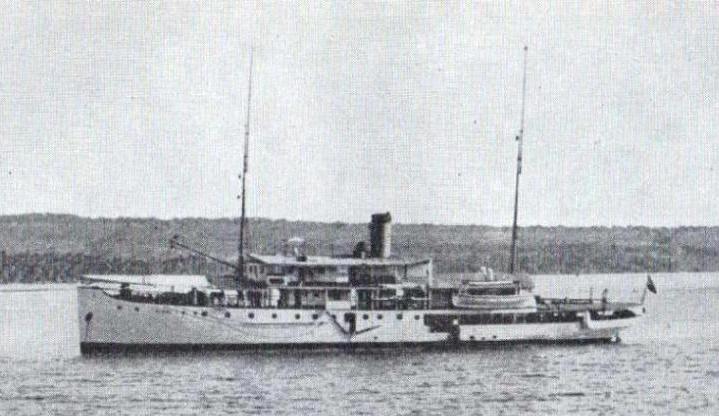ZATSUYOSEN!
 (HrMs GEMMA later KITA MARU, prewar)
(HrMs GEMMA later KITA MARU, prewar)
IJN KITA MARU:
Tabular Record of Movement
© 2016 Gilbert Casse and Peter Cundall
E 1917:
Schiedam (near Rotterdam), Netherlands. Laid down by Wilton-Fijenoord shipyard for the Royal Netherlands Navy (RNN).
1918:
Launched and named GEMMA.
1918:
Completed. GEMMA is to serve in the Dutch East Indies (DEI) as a patrol vessel.
1930s:
GM ss (Gouvernements stoomschip) patrol boat GEMMA is assigned to the Dutch civil navy. [1]
1 September 1939: World War II Begins:
Following the mobilization in the Netherlands, Governor-General Alidius W. L. Tjarda van Starkenborgh-Stachouwer decides to militarize the GM and it becomes a part of the Royal Netherlands Navy. The patrol boats are put under the RNN's East Indies Squadron.
2 September 1939:
The GM ships' new status is activated. This does not mean every GM ship is now under military orders, but GEMMA is one that is; she becomes Hr.Ms. GEMMA.
25 September 1939:
The CO GM is notified that GEMMA, VALK, FAZANT, AREND, MEREL, BELLATRIX, CASTOR, SIRIUS, REIGER, ZUIDERKRUIS, RIGEL and TYDEMAN are the only GM ships to receive orders from military authorities.
2 March 1942:
Scuttled by her crew in Surabaya, Java to prevent falling into Japanese hands.
27 October 1942:
Salvaged by Japanese Forces.
19 January 1943:
Maintenance directive is issued under Navy’s secret instruction No. 227.
January 1943:
Renamed KITA MARU.
28 January 1943:
Emergency repairs are completed by the 102nd Naval Construction Unit.
1 August 1943:
Registered in the IJN as an auxiliary transport attached to the Sasebo Naval District with Sasebo as homeport under Navy’s instruction No. 1572. Assigned to Vice Admiral (later Admiral) Takasu Shiro’s (35) Southwest Area Fleet as an auxiliary transport (Otsu) category. [2]
20 October 1943:
At 0830 arrives at Kota Baru, Borneo.
3 December 1943:
At 0700 due to depart Sourabaya.
5 December 1943:
Due to arrive at Kota Baru, Borneo.
1 March 1944:
At 1200, departs Surabaya in convoy also consisting of fleet oiler TSURUMI and auxiliary oiler KYOEI MARU escorted by minesweeper W-12 and auxiliary subchaser CHa-103.
2 March 1944:
At 1600, detached from the convoy.
3 March 1944:
Arrives at Balikpapan, Borneo.
3 June 1944:
Currently assigned to Vice Admiral (later Admiral) Takasu Shiro’s (35) Southwest Area Fleet in Vice Admiral Mikawa Junichi’s (38) 2nd Southern Expeditionary Fleet, 22nd Special Base Force. Departs Surabaya later that day in a convoy also consisting of IJN shared tanker (B/C-AO) JANBI (JAMBI) MARU and auxiliary oiler ENOSHIMA MARU escorted by minesweeper W-12.
6 June 1944:
Arrives at Kota Baru, Borneo.
10 June 1944:
Departs Kota Baru.
17 June 1944:
Arrives at Surabaya.
22 June 1944:
Departs Surabaya.
24 June 1944:
Arrives at Kota Baru.
1 July 1944:
Departs Kota Baru.
5 July 1944:
Arrives at Surabaya.
July 1944:
Departs Surabaya and arrives at Kota Baru.
20 July 1944:
Departs Kota Baru.
24 July 1944:
Arrives at Surabaya.
5 August 1944:
Engages in rescue mission of an unidentified ship in distress at 04-10S, 118-05E.
18 August 1944:
Departs Samarinda, Borneo.
21 August 1944:
Arrives at Balikpapan.
26 August 1944:
Departs Balikpapan.
27 August 1944:
Arrives at Kota Baru.
1 September 1944:
Departs Kota Baru.
7 September 1944:
Arrives at Surabaya.
18 September 1944:
Departs Surabaya.
21 September 1944:
Arrives at Balikpapan.
24 September 1944:
Engages in rescue mission of auxiliary transport HOKKAI MARU near Sebuku (Seboefoe) Island, Borneo. HOKKAI MARU is towed and beached there to prevent her sinking. [3]
28 October 1944:
Enters Surabaya drydock for maintenance and repairs.
15 December 1944:
At 0852, departs Surabaya in convoy SUBA-02 also consisting of IJA transport KENZAN MARU, civilian cargo ship (C-AK) TOKUSHIMA MARU and civilian tankers (C-AO) NANSHIN MARUs No. 12 and No. 16 escorted by minesweepers W-11 and W-103, subchaser CH-2 and auxiliary subchaser CHa-36.
19 December 1944:
At 0947, W-11 and subchaser CH-2 are ordered to join another convoy consisting of tug AKITSU MARU and gunboat NANKAI and are detached. KITA MARU is later also detached and arrives at Sebuku Island. Departs later.
23 December 1944:
Arrives at Surabaya.
15 August 1945:
End of hostilities. Survives the war.
3 May 1947:
Arrives at Macassar, Celebes (now Sulawesi).
3 May 1947:
Removed from the IJN Navy’s list under instruction No. 327-2.
Authors' Notes :
[1] GM ss (Gouvernements stoomschip). The Dutch civil navy, tasked with transport of government goods, charting sealanes and countering piracy, was militarized in 1939. It became a part of the RNN as the GGM (Gemilitairiseerde Gouvernementsmarine - Militarised Government Navy Force).
[2] There were two categories of Zatsuyosen. (Ko) category with an IJN Captain as supervisor aboard and (Otsu) category without.
[3] HOKKAI MARU struck a mine on 23 Sep ‘44.
Thanks go to Gengoro S. Toda of Japan.
Gilbert Casse and Peter Cundall.
Back to
IJN Transports Page





